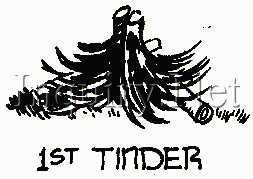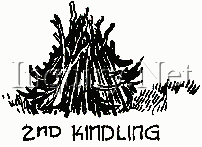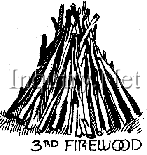The first thing you must do is to prepare a safe site for your fire. Clean the fire site down to the bare soil; remove all of the burnable material for a radius of 4 yards (or 4 meters) around it. Save the ground cover so you may put it back when you are finished.
Keep a pot of water, or bucket of sand/soil close to the fire for emergency.
If the site for the fire is grassy, use your camp shovel to cut around and under a 1 yard (or 1 meter) wide square of sod. Lift out the loosened sod, lay it right side up and sprinkle it with water. The grass should stay fresh until you replace it after you have broken camp.
Do not build a circle of rocks around your fire. If you must enclose it, use logs.
To start a fire you will require 3 sizes of wood: Tinder, Kindling, and Fuel. Gather enough of all three before you light your fire!

Tinder catches fire easily and burns fast. Wood shavings, fuzz sticks,
shredded bark, dry pine needles, and dry grasses all make good tinder. Gather enough to fill your
hat at least once.

Kindling is dry, dead twigs no thicker than a pencil. You will need to find
enough to fill your hat at least twice.

The fuel can be as thin as your finger or as thick as your arm. Use dead,
dry, sticks you find on the ground. Do not use green, live wood, as it is poor
fuel as it is full of moisture.
To Cook a Meal
Cook a simple meal over this fire. Bannock and tea is a traditional woods meal. Here's the recipe for campfire bannock:
| 4 cups flour | |
| 4 tsp baking powder | |
| 1 tsp salt | |
| 1 tsp sugar | |
| about 3 cups cold water |
Mix dry ingredients thoroughly and stir in enough water to make a thick batter that will pour out level. Mix rapidly with spoon until smooth. Pour into large greased frying pan and set on hot coals. Turn it over when bottom is brown. Cook until no dough sticks to a sliver of wood poked into the middle.
See Also: